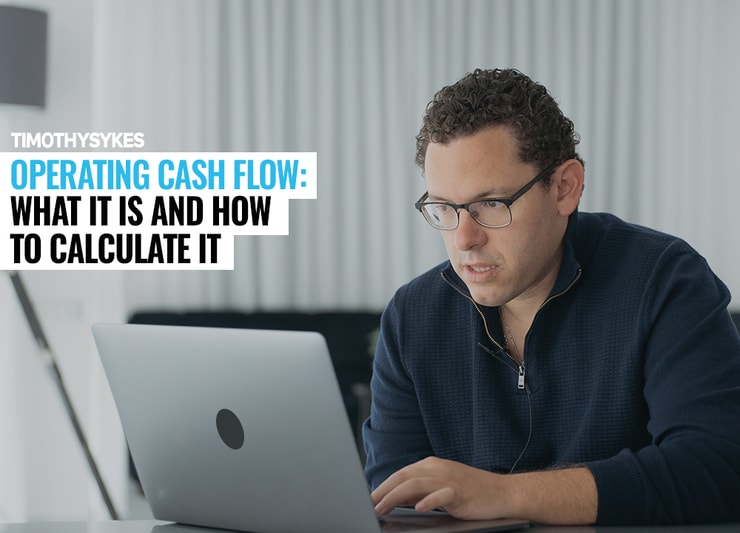I get a lot of questions from traders … Here’s one that pops up from time to time: “what is operating cash flow?”
Maybe you saw all the unicorns going public in 2019. Uber (NYSE: UBER), Peloton (NASDAQ: PTON), and Beyond Meat (NASDAQ: BYND) are just a few. Maybe these stocks got you into trading…
And maybe you heard that these companies are lacking in profits. That’s true. At this point, these companies lose more money than they make.
So why would anyone invest in a company that’s losing money?
Because traders and investors buy stocks they think will be worth more in the future. Investors want to buy below the value they expect in the future. Traders trade based on what they think will happen in the future.
So a lot of traders and investors use the data in a company’s public filings to try to estimate a company’s profits down the road.
Let me be completely up front with you — I’m not a value investor. I trade based on the current price action and chart patterns. Along with six more indicators all outlined in my Trader Checklist guide.
BUT, I’m a firm believer in knowledge. That’s why I think it’s important that you know all the market basics. That includes the operating cash flow. Let’s dig in and break it down. Plus, we’ll look at how it compares to other financial measures. Read on.
Table of Contents
What Is Operating Cash Flow?

2025 Millionaire Media, LLCYou can find the operating cash flow on a company’s quarterly or annual cash flow report. It summarizes a company’s income and expenses.
In short: it’s how much money the company generates in its normal operations.
Let’s look at BYND as an example. Its operating cash flow is revenue from producing plant-based burgers minus production and delivery costs (like materials and labor). I’m kinda oversimplifying here to give you the general gist.
The operating cash flow is really the company’s bread and butter. It’s the income we expect tomorrow and the day after that. Why so specific? Is there a non-operating cash flow? Yep.
Often companies sell a piece of property, stock shares, or even a division. The money from those sales is still considered income or cash flow. But since it isn’t from normal operations, it’s not included in the operating cash flow. Because it was likely a one-time event.
Once you sell an asset, you can’t sell it again. Selling the main products or services is considered the operating activity. That’s the recurring income companies expect to make over and over again.
All companies have three different types of activities — operating, financing, and investing. Operating cash flow deals only with operating activities.
There are two ways to measure operating cash flow … indirect and direct. Operating cash flow is only a portion of what investors research. Let’s start with the indirect method for measuring operating cash flow…
Indirect Method
If you’ve ever taken an accounting class (and paid attention) you’ve heard of the two main methods of accounting — accrual and cash. Wall Street wanted to be different, so they call it indirect and direct.
The indirect method is the most typical for large publicly traded companies. It’s the same as the accrual method in accounting.
The indirect method records all sales and expenses as they occur. This is important to understand because the balance a company reports isn’t actual cash on hand. Instead, it’s the expected amount of cash on hand once all accounts are settled. It’s what’s left after your customers pay and you pay all your bills.
Let’s look at this from another angle to be really clear…
Customers don’t always immediately pay for purchases. Sellers send out bills that the customer can pay at a later time. That’s typically 30–60 days in the future (NET 30 and NET 60).
The delayed payments result in two ‘buckets’ of money. One is accounts receivable — that’s all the money your customers owe you. The other is accounts payable — that’s all the money you owe.
So when calculating operating cash flow using the indirect method, you include accounts receivable and accounts payable in the cash flow. Even though that cash hasn’t been settled yet.
Direct Method
The direct method is more, well … direct. This is a simpler way to go. Many smaller mom-and-pop companies use this method.
The direct method is used on a cash-accounting basis. You count your income only after you receive it. That’s whether you receive the money at the point of sale or later from an invoice.
The direct method counts the money you receive, whether cash, check, or bank deposit. You record the revenue only once you get it.
And you record expenses after you pay them — not when you receive the bills or they’re due.
So, with the direct method, you only record the money you receive and only subtract the bills you pay.
More Breaking News
- Baytex Energy Stock Rises Amid Strategic Partnerships and Financial Resilience
- HL Stock Fluctuations: Time to Gather Insights?
- Invest or Ignore? The Top Penny Stocks Ahead of Tariff Deadline
Operating Cash Flow vs. EBITDA
EBITDA can seem obscure. It exists only on Wall Street. It stands for earnings before interest, taxes, depreciation, and amortization.
No accounting method uses EBITDA for any measure. You won’t see a tax bill referencing the EBITDA.
Some investors dismiss it because it doesn’t tell the entire story. But it can be a useful measure if you want to look exclusively at the earnings. It can shed some light on underlying profitability … or lack thereof.
But EBITDA isn’t a measure of the overall company’s financial situation. So take these numbers with a grain of salt.
EBITDA looks at earnings in a vacuum. It ignores all taxes, interest, financing, and assets to evaluate if a company’s operations are profitable. And a positive number doesn’t necessarily mean the company is or ever will be profitable…
My first millionaire student** Michael Goode actually put together a great DVD guide explaining the inner workings of SEC filings. This is a must-watch guide if you want to understand how to read SEC filings.
Operating Cash Flow vs. Net Income
Net income is reported on the income statement of financial disclosures. It’s a component of operating cash flows. But, like everything else we’ve discussed so far, it doesn’t include everything.
Net income includes a lot — total revenues, operating expenses, research and development, administrative costs, interest, and taxes. Just to name a few. It’s a more thorough look at a company’s finances, especially compared to EBITDA.
Since net income is more inclusive, it can be a more reliable indicator of a company’s profitability.
When a company has a positive net income, it’s on its way to becoming profitable. When the net income is negative, the company is operating at a loss … It likely has more work to do to be profitable.
But — you guessed it — there’s more to it. Net income isn’t the bottom line…
Operating Cash Flow vs. Free Cash Flow
Free cash flow is the best kind of cash flow for creditors and investors. Operating cash flow is the earnings from regular business activities.
Free cash flow is the ‘leftover’ cash after everything else is paid. Free cash flows are the resulting profit or loss for the entire company. It’s the bottom line and reported at the bottom of the cash flow statement. It accounts for a company’s activities — operating, investing, and financing.
All the companies I mentioned at the beginning of this post are operating at a loss. They have negative amounts in free cash flow.
Going back to those accounting basics, free cash flow is the equivalent of the owner’s equity. Here’s the formula:
[Total Assets] – [Total Liabilities] = Owner’s Equity
For the purposes of publicly traded companies, the stockholders are the owners. They’re the last to get paid … if they get paid at all.
If the company wants to reward stockholders, it can issue a dividend. Cash dividends come out of the free cash flow. But it’s considered an investing activity and recorded separately from the operating activities.
The company must be turning a profit to have any money left over in the form of free cash flow. That means bringing in more operating cash flow to cover all expenses.
Not every company needs to have free cash flow to be successful. Many companies reinvest all profits before they turn into free cash flow. For growing and expanding companies, not having free cash flow isn’t necessarily a bad thing.
Operating Cash Flow Examples

2025 Millionaire Media, LLCI pulled some numbers from the income statements and cash flow statements of the companies I mentioned at the beginning.
It’s worth noting that all of them are losing money despite having hundreds of millions of dollars in operating cash flow. As a point of reference, I’m including the market cap. That’s the current valuation for the whole company based on the current stock price at writing.
- UBER’s market cap is $58 billion. Its operating cash flow from 2018 was -$1.5 billion. Its net income was $1 billion, EBITDA was $2.4 billion, and free cash flow was -$2.1 billion.
- PTON has a market cap of $8 billion. Its operating cash flow from 2019 was -$109 million, and its net income was -$196 million. The EBITDA was -$181 million and free cash flow was -$192 million.
- BYND has a market cap of $8.3 billion. Its operating cash flow from 2018 was -$38 million. Its net income was -$26 million. The EBITDA was -$24 million and free cash flow was -$61 million.
As you can see, the numbers are all over the place. There‘s no way the average investor can accurately predict these numbers ahead of time. The valuations don’t follow any order or logic.
A complete audit of all the revenues, profits, and losses can never account for something like a short squeeze. It’s good to understand the numbers behind the stock, but they aren’t great indicators of how the stock’s price might move.
Here’s a short video where I explain why you don’t need to pour over these numbers when trading penny stocks. (Hint: at the 1:58 mark, I explain how to avoid being disappointed with penny stocks.)
The Importance of Operating Cash Flow
Why is operating cash flow important? It’s the only constant source of income a company can expect to have in the long run.
Investing and financing activities are extremely important … especially when a business is in the early stages of growth. But they don’t provide long-term solutions. Only operating activities can push a company to profitability in the long run.
Sometimes you hear about a company selling a portion of its business for millions or billions of dollars … And the stock price drops the next day.
Remember what I said earlier. Everyone who buys stocks does so based on what they think will happen next. So if a company sells off a profitable division, sure it can get more cash now. But the operating cash flow will likely go down.
The opposite is often true too … If the company sells off or closes an unprofitable division, the stock price can rise.
I don’t try to predict the next market move based on news or a filing. One of my methods from over 20 years of trading is to react to the market.
How to Calculate Operating Cash Flow
We covered calculating the operating cash flow using the direct and indirect methods above…
Here’s what you should really know … The operating cash flow is income from operations. It’s the money a company generates through normal business operations. That’s its only source of long-term income.
No other income should be a factor in determining a company’s long-term viability.
And there’s no need for you to actually calculate these numbers yourself. They’re all readily available in public filings. But it’s good to know where these numbers come from.
What Is Operating Cash Flow Ratio?
The operating cash flow is a basic measure of liquidity. It shows a company’s ability to cover short-term expenses with its current operating cash flow.
Here’s how to calculate the operating cash flow ratio:
[Operating Cash Flow] / [Current Liabilities] = Operating Cash Flow Ratio
Anything over 1.0 tells you the business is self-sufficient in the short term. The current operating cash flows can cover current expenses.
When the number falls below 1.0, you may need to dig deeper … How much cash is already on hand? When does the company expect to have a ratio above 1.0?
Some companies — like Uber, Peloton, and Beyond Meat — rely heavily on outside financing, loans, and selling stock to cover expenses. They all operate below 1.0
Frankly, this is why I don’t trade blue-chip stocks. They’re too complex. The competition is too fierce. I stick to penny stocks because they tend to move based on emotions and recent press releases.
Operating Cash Flow Formula
You can calculate the operating cash flow with this ‘simple’ formula:
[Net income] + [Noncash Expenses] + [Changes in Working Capital] = Operating Cash Flows
Simple, right? NOT!
I won’t dive into all these terms today. That’s a class I’m not even qualified to teach.
The good news is you don’t need to understand every inner working of a cash flow statement to trade stocks. I think it’s smarter to learn these lessons first. Understand what trading is and isn’t.
If you’re interested in learning more about fundamentals, you gotta study. A LOT. Mark Crook** is one of my millionaire students who has a tremendous understanding of what goes into these numbers. He’s learned what to look for.
He created an amazing video lesson about fundamentals. He reviews what he looks at and how he uses this information. Trading Challenge students can access the video lesson here. (Hint: you gotta log in to your account first.)
If you’re not yet a Challenge student — apply here today. It’s the most comprehensive training program I offer. Mark is one of the mentors and chat room moderators for the Trading Challenge program.
Fun fact: Mark watched every video lesson in the library (over 6,000) three times … then categorized them. He’s a treasure trove of trading strategies. (Once you’re in, search for this video lesson: #443: My Favorite Short Opportunity in the Markets Right Now!)
Conclusion
Reading the financial fundamentals can give you insight into where a stock might go in the future. But few individual traders can consistently make money using the operating cash flow and other metrics.
It’s smart to know the difference between operating cash flows, EBITDA, net income, and free cash flows. But you don’t need to trade from these numbers to be successful.
What I think is important is that you invest in your knowledge account and fit your trading style to your life.
For me, it’s too hard to figure out what all these numbers mean for each individual stock. Call me lazy, but I’ll stick to what works for me.
If you’re new the markets, that’s OK. Start here with a few stocks I’m watching.
Finding the right stocks to trade is a challenge. Get a jumpstart with my FREE trader checklist.
And get my no-charge weekly stock watchlist here.
Operating income is just one measure of a company’s financial health. Add this knowledge to your market understanding. Keep studying and never stop learning!
[**Note that these results aren’t typical. These students put in the time and dedication and have exceptional skills and knowledge. Most traders lose money. Always remember trading is risky … never risk more than you can afford.]
What do you think of this post? Share your thoughts in the comments below!












Leave a reply